8+ SAMPLE Co-Branding Agreement
-
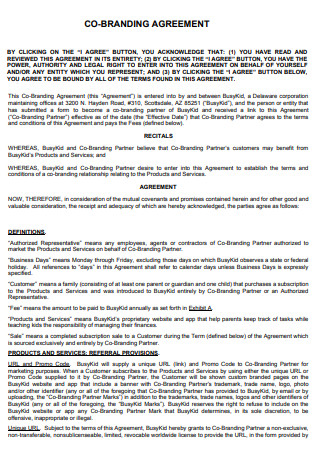
Co-Branding Agreement
download now -
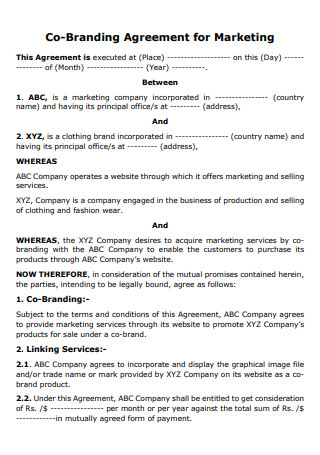
Co-Branding Marketing Agreement
download now -
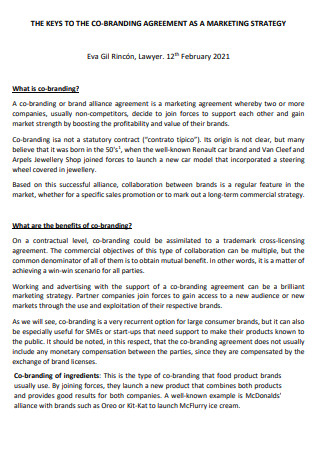
Co-Branding Marketing Strategy Agreement
download now -
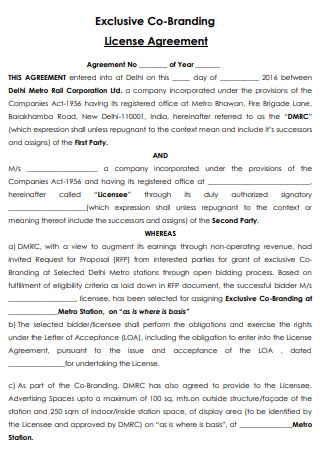
Exclusive Co-Branding License Agreement
download now -
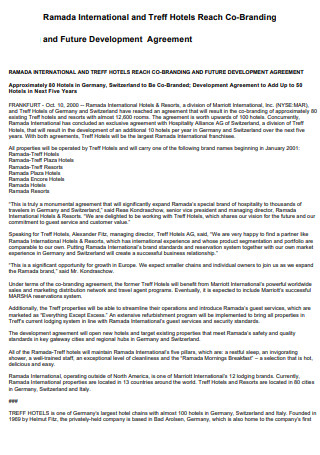
Hotel Co-Branding Development Agreement
download now -

Co-Branding Stock Exchange Strategic Agreement
download now -

Co?Branding Educational Agreement
download now -

Co?Branding Subscription Agreement
download now -

Co?Branding Sponsorship Agreement
download now
FREE Co-Branding Agreement s to Download
8+ SAMPLE Co-Branding Agreement
What is a Co-Branding Agreement?
Types of Co-branding
How to Write a Co-Branding Agreement
Pros of Co-Branding
Essential Features of Co-branding Agreements
FAQs
What is the distinction between collaboration and co-branding?
What is the definition of a collaboration agreement?
What are the drawbacks to co-branding?
What is a Co-Branding Agreement?
Co-branding Agreements are agreement document that gives trademark owners a way to broaden their consumer reach and build a fan following. It entails combining well-known brands with consumer or retail-oriented brands. Considerably co-branded social media personality marketing has grown popular. Co-branding is a type of line that is used as an extension to develop new goods with a new feature by leveraging trademarks from a different firm to reach a new audience for a specific product, according to marketers. The main premise of co-branding is that the brands should collaborate resulting in an improbable consequence of direct competitors’ co-branding. Feel free to check out the co-branding agreement template available for your use.
Types of Co-branding
There are two different types of co-branding that you can use to your knowledge. Being knowledgeable will help you to be aware of which type will better fit your Company and the agreed partner company. Read this short segment on the two types of co-branding to learn more about them and apply it to your future endeavors in dealing with companies who will be partnering with your own.
How to Write a Co-Branding Agreement
Many brands, as part of a Branding strategy, want to conduct business with as many different firms as possible because they believe it will provide them greater visibility and money in the long term; but, if you do not pick your partners correctly, this can backfire. The key to any successful collaboration is to choose partners that complement rather than compete with your products or services. The co-branding agreement may appear intimidating, but with little planning and advice from this article, it will be a lot easier to put together. You can also use as a reference the provided co-branding agreement sample this article has prepared.
Step 1: Relevant Details of Effectivity
Include the name of your company or business as well as the name of the partner company or Business you are contacting. The most crucial thing is to identify who you want as partners. Consider how big their network is and how well-known they are in the industry. Your company partner is invited to share your co-branding area under the terms of a co-branding agreement. As a result, explain how your brands complement one another. Talk about their brand and how it fits in with yours. Any co-branding plan must have the ability to properly define what makes up another company’s brand.
Step 2: List out the Benefits
You will need to include some real statistics in your agreement to show how the co-branding will benefit both of you. What are the benefits of this arrangement for each party? What kind of return on investment do you think you will get? Are you able to name a number? How did you come up with this figure? Because most companies have little experience with co-branding, providing good data will go a long way toward persuading them that your plan is viable. Be realistic in your expectations: you can’t always receive what you desire.
Step 3: Terms and Conditions
Describe in as much detail as possible how it will operate. What will the substance of your mails, for example, be? What are your plans for their logo? What address will you use to send the mailing? What is the logistics situation? Who will have ownership of and control over each piece of marketing collateral? How frequently does one party require consent from the other party for campaigns, etc.? What are the objectives of this campaign or collaboration? Include information on how involved the other company will be in the agreement. They will want to know that they have some say in how their brand is employed.
Step 4: Calculate the Budget
You should include an exact Cost estimate as part of your calculations. Everything should be planned ahead of time, from manufacturing to distribution. When it comes time to examine your proposal, this figure will be crucial for any possible co-branding partner. Do, however, phrase it in terms of the benefit they will receive. It’s critical to emphasize that co-branding isn’t the same as purchasing another marketing effort. Demonstrate to them that they will receive free advertising and that you, too, are contributing to the expense.
Step 5: Duration of the Agreement
The length of the co-branding campaign is the last item you should supply. Make it brief and to the point. No company wants to be trapped into an open-ended agreement, especially for a first attempt. The most convenient proposition is a small direct mail run, followed by a shared analysis of the outcomes. You will be in a strong position to run another if this goes well. You should have a better sense of what to include in any co-branding proposal by now. Keep the proposal focused on the benefits of the relationship, whether it’s for your firm or another group. Before you do anything else, make sure that all parties involved have agreed to these conditions.
Pros of Co-Branding
The activity of two or more companies or brands collaborating on a marketing campaign is known as co-branding. For both corporations or brands, the purpose is to advertise and sell new products or services. You can employ comparable marketing concepts in a single public presentation or combine numerous themes if you wish. When weighing the benefits and drawbacks of co-branding in today’s industry, keep the following considerations in mind.
Essential Features of Co-branding Agreements
Co-branding is treated as a trademark licensing arrangement rather than a joint venture or partnership agreement in legal terms. A Trademark cross-licensing structure is used in a co-branding framework, with each party leasing its rights to the other. Co-Branding Agreements have the ability to benefit both parties because of their power and influence. The cross-license will be able to depend on each party’s existing Intellectual Property rights for launching a co-branded product in new areas if the Co-Branding agreements are well designed. Take note of the following.
FAQs
What is the distinction between collaboration and co-branding?
Co-branding is more of a branding effort, whereas collaboration is more of a marketing effort. Often times a marketing strategy can be utilized for the two parties to collaborate their companies together. Two brands will collaborate to develop a combined product that embodies both of their brand identities in a co-branding agreement.
What is the definition of a collaboration agreement?
A collaboration agreement is a legally enforceable agreement between two or more parties who desire to collaborate on a commercial project. It specifies how the parties will collaborate and divides the advantages, liabilities, and obligations established by or for the project between them.
What are the drawbacks to co-branding?
Composite branding isn’t a good idea if the firms don’t have similar aims and ambitions. Partner brands may suffer as a result of co-branding. If buyers identify negative characteristics and experiences with one of the brands, the whole brand equity may suffer. Be sure that when you make use of a Brand Partnership Agreement template is that you have the details settled and with a clear understanding for both parties.
Signing documents is necessary to legally bind and enforce the agreement between both companies that showcases their acknowledgments with the contents. Moreover, an agreement that has been duly signed by both companies will show that both parties are pleased with the arrangement and have no further questions regarding the details for the co-branding. Although, some changes or minor tweaks may not be avoided, so including them in a co-branding agreement would also be essential. Afterward dealing with an agreement, check out an available contract template which you can also use between the agreement for both companies.
